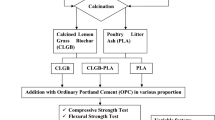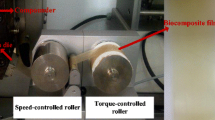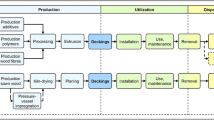Abstract
The aim of this study is to analyse the environmental impacts (EIs) of the process of preparation of new biocomposite materials obtained from polylactide (PLA) and chicken feathers (CFs). Two CFs stabilization methods and different percentages of CFs have been studied. The EIs of these new composites were compared to the impact of virgin PLA. Cradle-to-gate life cycle inventories were assessed for 0–35% v/v of CFs in a CFs/PLA biocomposite. Two CFs stabilization processes, autoclave and surfactant, were tested and compared with the aim to prioritize one of them from the environmental point of view. A composite plate of 184 × 184 × 2.2 mm3 was defined as the functional unit. Autoclave stabilization process exhibited lower environmental impact compared with surfactant stabilization process mainly due to both the lower requirements of electricity and water and the reduced pollution loads of the generated wastewater. Thus, the autoclave process was selected as the standard method when comparing the EIs of the proposed CFs/PLA biocomposites. In this sense, the addition of CFs to PLA matrix proportionally reduces all the EIs compared to pure PLA due to the replacement of PLA with CFs. This behaviour can be explained because the PLA production accounts for the 99% of the impact of the biocomposite. Consequently, CFs conveniently stabilized might be an alternative raw material to prepare CFs/PLA biocomposites with less environmental impact compared to pure PLA.




Similar content being viewed by others
References
Joshi S, Drzal L, Mohanty A, Arora S (2004) Are natural fiber composites environmentally superior to glass fiber reinforced composites? Compos Part A Appl Sci Manuf 35:371–376
Corbiere-Nicollier T, Gfeller-Laban B, Lundquist L, et al. (2001) Life cycle assessment of biofibres replacing glass fibres as reinforcement in plastics. Resour Conserv Recycl 33:267–287
Wotzel K, Wirth R, Flake M (1999) Life cycle studies on hemp fibre reinforced components and ABS for automotive parts. Die Angew Makromol Chem 272:121–127
Xu X, Jayaraman K, Morin C, Pecqueux N (2008) Life cycle assessment of wood-fibre-reinforced polypropylene composites. J Mater Process Technol 198:168–177
Álvarez-Chávez CR, Edwards S, Moure-Eraso R, Geiser K (2012) Sustainability of bio-based plastics: general comparative analysis and recommendations for improvement. J Clean Prod 23:47–56
Baillie C (2004) Green Composites, Polymer composites and the environment. Woodhead Publishing Ltd, Cambridge
Barone J, Schmidt W (2006) Composites and films comprised of avian feather keratin. 10/805,558
Wool R, Hong C (2005) Development of a bio-based composite material from soybean oil and keratin fibers. J Appl Polym Sci 95:1524
Barone J, Schmidt W (2005) Polyethylene reinforced with keratin fibers obtained from chicken feathers. Compos Sci Technol 65:173–181
Cheung HY, Ho MP, Lau KT et al. (2009) Natural fibre-reinforced composites for bioengineering and environmental engineering applications. Compos Part B Eng 40:655–663
Huda S, Yang Y (2009) Feather fiber reinforced light-weight composites with good acoustic properties. J Polym Environ 17:131–142
Wallenberger F, Weston N (2004) Natural fibers, plastics and composites. Kluwer Academic Publishers, Boston
Garraín D, Vidal R, Franco V (2007) Land use in LCA of biomaterials. In: 3rd International Conference Life Cycle Management, LCM 2007
Reddy N (2007) Structure and properties of chicken feather barbs as natural protein fibers. J Polym Environ 15:81–87
AVEC (2015) Annual report of the Assiciation of Poultry Processors and Poultry Trade in the EU countries. Brussels
Carrillo F, Macanás J, Colom X, et al. (2012) Use of chicken feathers waste for the fabrication of composite materials. In: 15th European conference on composite materials, Venice, pp. 1–8.0026
Instituto Markin (2009) Estudio sobre los subproductos generados en los mataderos de pollos. Año 2009, Valencia
Garraín D, Vidal R, Martínez P, et al. (2007) How green are biopolymers? In: 16th International Conference on Engineering Design ICED’07
Cañavate J, Aymerich J, Garrido N, et al. (2016) Properties and optimal manufacturing conditions of chicken feathers/PLA biocomposites. J Compos Mater 50: 1671–1683
Granta Design Limited (2012) CES EduPack software
Kock J (2006) Physical and mechanical properties of chicken feather materials. Ph.D thesis, Georgia Institute of Technology
Wrzesniewska-Tosik K, Wawro D, Ratajska M, Steplewski W (2007) Novel biocomposites with feather keratin. Fibres Text East Eur 15:157
Cheng S, Lau K, Liu T, et al. (2009) Mechanical and thermal properties of chicken feather fiber/PLA green composites. Compos Part B Eng 40:650–654
Carrillo F, Rahhali A, Canavate J, Colom X (2013) Biocomposites using waste whole chicken feathers and thermoplastic matrices. J Reinf Plast Compos 32:1419–1429
Colom X, Rahalli A, Cañavate J, Carrillo F (2013) Properties and optimal manufacturingconditions of chicken feathers thermoplastic biocomposites. J Compos Mater 49: 295–308
Vink ETH, Glassner DA, Kolstad JJ, et al. (2007) ORIGINAL RESEARCH: The eco-profiles for current and near-future NatureWorks® polylactide (PLA) production. Ind Biotechnol 3:58–81
Madival S (2009) Assessment of the environmental profile of PLA, PET and PS clamshell containers using LCA methodology. J Clean Prod 17:1183–1194
Shen L, Worrell E, Patel M (2010) Present and future development in plastics from biomass. Biofuels Bioprod Biorefining 4:25–40
Martínez-Hernández AL, Velasco-Santos C (2012) Keratin fibers from chicken feathers: structure and advances in polymer composites. In: Dullaart R et al (eds) Keratin Struct. Prop. Appl, Nova Science Publishers, Inc., pp 149–211
Garrido N, Aymerich J, Colom X et al (2011) Optimal manufacturing conditions of chicken feathers/PLA biocomposites. In: 12th Mediterranean congress of chemical engineering. p.21_045_P
Macanás J, Molins G, Álvarez MD, et al. (2011) Physicochemical characterization of a valorisable waste: chicken feathers. In: 12th Mediterranean congress, p.21_025_P
Weidema BP, Bauer C, Hischier R, et al. (2013) Data quality guidelines for the ecoinvent database version 3: Overview and methodology (final)
Eugene W. Rice, Rodger B. Baird, Andrew D. Eaton LSC (2012) Standard Methods for the Examination of Water and Wastewater. Am Water Work Assoc Public Work Assoc Environ Fed 1469
González-García S, Gomez-Fernández Z, Dias AC et al (2014) Life Cycle Assessment of broiler chicken production: a Portuguese case study. J Clean Prod 74:125–134
PRé Consultants (2014) SimaPro 8.0 Life Cycle Assessment Software Package
European Comission, Joint Research Centre, Institute for Environment and Sustainability (2010) International reference Life Cycle Data System (ILCD) Handbook—General quide for Life Cycle Assessment—Detailed quidance, First
Ministrerio de Agricultura P, y A (2007) Libro blanco subproductos de origen animal no destinados al consumo humano. Ministrerio de Agricultura, Pesca y Alimentación. Madrid
Organisation IS (2006) ISO 14040:2006 Environmental managenet—Life cycle assessment—Principles and framework. Norma ISO
Vidal R (2009) Life cycle assessment of composite materials made of recycled thermoplastics combined with rice husks and cotton linters. Int J life cycle Assess 14:73–82
Heijungs R, Huppes G, Guinee J (2010) Life cycle assessment and sustainability analysis of products, materials and technologies. Toward a scientific framework for sustainability life cycle analysis. Polym Degrad Stab 95:422–428
Goedkoop M, Heijungs R, Huijbregts MAJ et al (2013) ReCiPe 200 8 A life cycle impact assessment method which comprises harmonised category indicators at the midpoint and the endpoint level. The Netherlands
Le Duigou A (2012) PLLA/flax mat/balsa bio-sandwich-environmental impact and simplified life cycle analysis. Appl Compos Mater 19:363–378
Prudêncio da Silva V, van der Werf HMG, Soares SR, Corson MS (2014) Environmental impacts of French and Brazilian broiler chicken production scenarios: an LCA approach. J Environ Manag 133:222–231
Acknowledgements
FEDER and the Spanish Ministry of Science and Innovation funding (MAT 2010–17057) are gratefully acknowledged.
Author information
Authors and Affiliations
Corresponding author
Rights and permissions
About this article
Cite this article
Molins, G., Álvarez, M.D., Garrido, N. et al. Environmental Impact Assessment of Polylactide(PLA)/Chicken Feathers Biocomposite Materials. J Polym Environ 26, 873–884 (2018). https://doi.org/10.1007/s10924-017-0982-9
Published:
Issue Date:
DOI: https://doi.org/10.1007/s10924-017-0982-9




